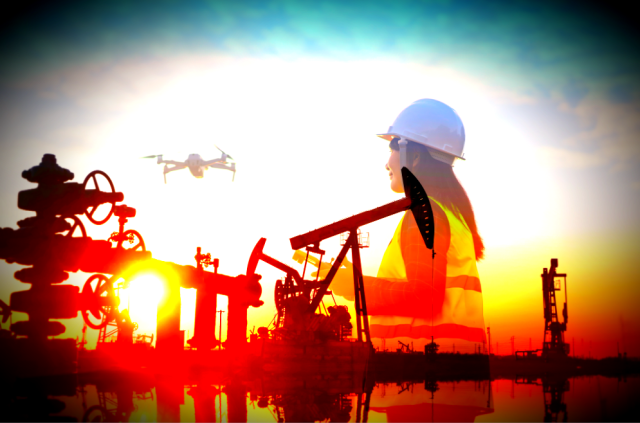
Not only do technologies like drones, AI and cloud-computing provide much needed assistance during the pandemic, but with low oil prices on the horizon for the foreseeable future, they also present an opportunity for oil and gas companies to develop long-term efficiency. (Source: Shutterstock.com)
Oil and gas companies have done much in recent years in order to boost efficiency, cut costs and ultimately make more money at lower commodity prices. The digital transformation of the industry has accelerated at an unexpected rate due to the outbreak of COVID-19. Restrictions on travel and social interaction proved that energy companies have the ability to conduct field operations at a distance. Now that we are firmly in the grips of a second wave, these restrictions will undoubtedly return in some shape or form, and the oil industry will undoubtedly continue to adapt.
There are multiple pieces of exceptional technology currently being utilized by oil and gas companies in order to adapt to the changes brought about by the pandemic. From fiber optic networks and cloud-computing to drones and artificial intelligence (AI), to name just a few. Not only do these technologies provide much needed assistance during the pandemic, but with low oil prices on the horizon for the foreseeable future, they also present an opportunity for oil and gas companies to develop long-term efficiency.
Below is a comprehensive look into how the oil sector has seen a permanent change in its tech in response to the pandemic of 2020.
Artificial Intelligence
The drilling process is comprised of a huge variety of enormous datasets. AI can be utilized in order to analyze these datasets far more efficiently than any human could. Although data has, in its own right, essentially become a form of currency—it’s synonymous with oil in the sense that, if left unrefined, its uses are severely limited.
Valve positions, flow rates and temperature are just a few of the various aspects of the sector, from which an extensive amount of data stems from. If done in the traditional manner, these unconsolidated data sets would take an incredibly long time to package into anything even slightly usable. AI technologies—put to use by engineers and geologists alike—are able to pick out patterns with systematic ease, as well as identify and flag poor performance in wells and reservoirs.
The iconic concept of AI existing to replace professionals, is certainly not true when it comes to the oil and gas industry. Rather than remove the need for professionals, AI technologies exist to bolster their analyses and decision-making. This is incredibly useful as it results in a much quicker rectification of any issues that may arise, and has been a huge asset amidst the uncertainty of the pandemic. Digital and AI processes have even helped to increase recoverable oil and gas resources by approximately 5%.
Robotics
Regardless of the setting, offshore or onshore, you will find that robotics are well-utilized. As oil supplies gradually decline, new oil well locations have been found to be increasingly uninhabitable, which subsequently risks the health and safety of anyone on the site. Robotic assistance is predominantly implemented in order to carry out essential inspection, maintenance and repair tasks. This ensures the safety of all those on the site. Further to this, these essential tasks could not be completed any other way whilst individuals work remotely throughout the pandemic.
Both semi-autonomous and fully-autonomous robots are utilized for a range of processes, several of which include:
Wireless Sensors. A comprehensive feedback network is created by installing wireless sensors along pipelines. The integrity and overall health of the pipeline infrastructure is regularly updated thanks to these sensors, which removes any time-consuming need for manual inspection.
Pipe Inspection. The long-standing, traditional method of inspecting pipelines involved digging up the pipe, itself. This was both expensive and incredibly time-consuming. In-Pipe Inspection Robots (IPIRs), on the other hand, have multiple testing capabilities, allowing for a thorough inspection of all pipelines without unnecessary time or monetary wastage.
Drill Floor Robots. These advanced pieces of completely unmanned equipment are capable of handling such things as pipework and drill heads. Entrapment is a particularly prevalent form of injury in an oil field setting. This involves a driller’s hands, arms, feet or legs being trapped between pipes or large pieces of drilling equipment. This risk is mitigated entirely with the implementation of drill floor robots. On top of this, they also improve reliability, whilst reducing costs and overheads. This streamlined drilling process results in a much safer and more productive oil company.
Drones
An incredibly exciting addition to the oil and gas industry; drone technology has proven its functionality in a multitude of ways. With the assistance of drones, essential processes can be completed without the necessity for individuals to sacrifice the social distancing measures they have been following throughout the pandemic. Drones are heavily utilized in multiple processes, including those listed below:
Pipeline Assistance
Leakages found in pipelines can cause heaps of financial stress, but their environmental repercussions are arguably much more worrisome. Pipeline leakages are an appallingly common occurrence, considering the magnitude of the issue. To put it into perspective, the U.S. experienced an estimated 6,000-plus pipeline incidents between 2010 and 2019.
Being a traditionally labor-intensive job, pipeline incidents would frequently crop up as the pipelines themselves are considerably difficult to monitor regularly. Until recently, physical inspection was the only way to spot potential or significant faults within the pipe. With the new-age of technology, however, comes drones, which simplify this process to the extreme.
Surveillance
Drilling operations are immensely expensive—both the drilling equipment and the operations themselves. With this in mind, all drilling sites make sure to have an exceptional level of surveillance and general security. Drones are able to monitor the entire site at all times, and also provide surveillance images of a far higher quality than anything provided by security guards or static cameras.
Exploration of Potential New Sites
Before a new oil and gas site can be settled upon, it’s essential to carry out a thorough site exploration. This can be done far more efficiently with the assistance of drone technology. Both aerial and underground explorations can be carried out—with a range of video imagery, 3D modelling, infrared analysis, and much more being reported back.
Geographical and topographical surveys were once a considerably difficult task to carry out, but drone technology has made this job much easier. Oil and gas companies can now access pictures that are substantially more detailed and accurate than anything provided through a more traditional process. With this information, oil and gas companies are able to make decisions that yield more impressive results.
Conclusion
The multiple pieces of technology, that have revolutionized the oil and gas industry in recent years, do much to ensure processes run as efficiently as possible, whilst also keeping individuals safe. As oil prices have plummeted in recent months, this has been a huge help to the industry and is sure to continue once normality finally resumes.
About the Author:
Henry Berry is director at TriStone Holdings Ltd., an energy company based in the U.K. with a primary focus in the U.S. TriStone finds, develops and produces essential sources of energy and their portfolio includes high-quality conventional oil and natural gas assets in the top U.S. onshore plays.The company is currently raising capital to acquire and expand its energy base, specifically in the oil and gas sector.
Recommended Reading
California Resources Corp. Nominates Christian Kendall to Board of Directors
2024-03-21 - California Resources Corp. has nominated Christian Kendall, former president and CEO of Denbury, to serve on its board.
Humble Midstream II, Quantum Capital Form Partnership for Infrastructure Projects
2024-01-30 - Humble Midstream II Partners and Quantum Capital Group’s partnership will promote a focus on energy transition infrastructure.
President: Financial Debt for Mexico's Pemex Totaled $106.8B End of 2023
2024-02-21 - President Andres Manuel Lopez Obrador revealed the debt data in a chart from a presentation on Pemex at a government press conference.
NOV's AI, Edge Offerings Find Traction—Despite Crowded Field
2024-02-02 - NOV’s CEO Clay Williams is bullish on the company’s digital future, highlighting value-driven adoption of tech by customers.
Hess Corp. Boosts Bakken Output, Drilling Ahead of Chevron Merger
2024-01-31 - Hess Corp. increased its drilling activity and output from the Bakken play of North Dakota during the fourth quarter, the E&P reported in its latest earnings.




